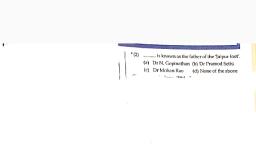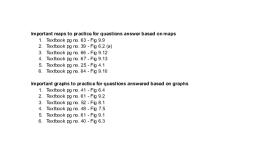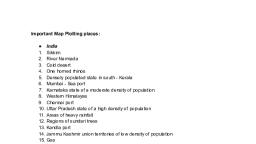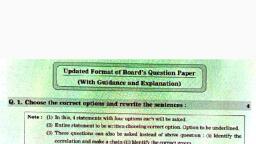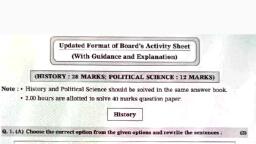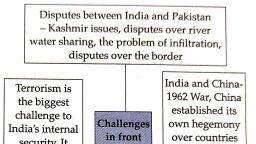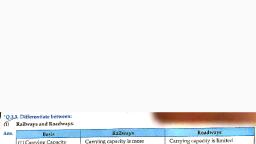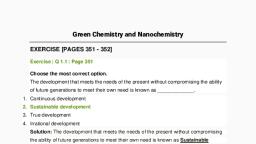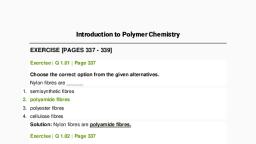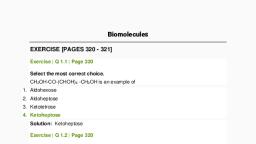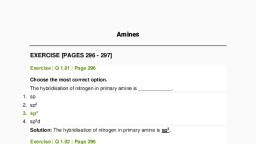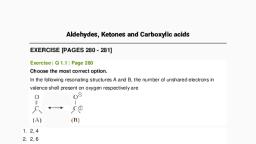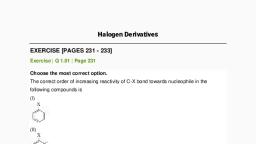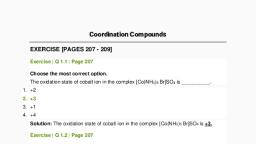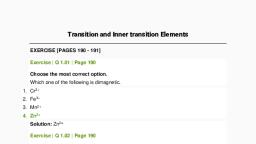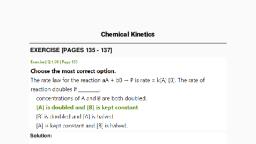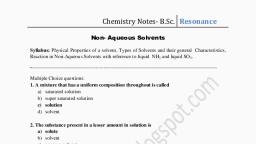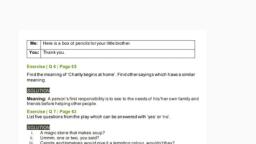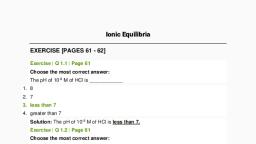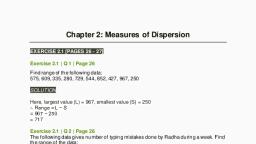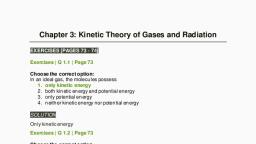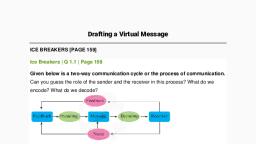Page 1 :
Elements of Groups 16, 17 and 18, EXERCISE [PAGES 163 - 164], Exercise | Q 1.01 | Page 163, Select appropriate answers for the following., Which of the following has highest electron gain enthalpy?, 1. Fluorine, 2. Chlorine, 3. Bromine, 4. Iodine, Solution: Chlorine, Exercise | Q 1.02 | Page 163, Select appropriate answers for the following., Hydrides of group 16 are weakly acidic. The correct order of acidity is ______., 1. H2O > H2S > H2Se > H2Te, 2. H2Te > H2O > H2S > H2Se, 3. H2Te > H2Se > H2S > H2O, 4. H2Te > H2Se > H2O > H2S, Solution:, Hydrides of group 16 are weakly acidic. The correct order of acidity is H2Te > H2Se >, H2S > H2O., Exercise | Q 1.03 | Page 163, Select appropriate answers for the following., Which of the following element does not show an oxidation state of +4?, 1. O, 2. S, 3. Se, 4. Te, Solution: O
Page 2 :
Exercise | Q 1.04 | Page 163, Select appropriate answers for the following., HI acid when heated with conc. H2SO4 forms _______., 1. HIO3, 2. KIO3, 3. I2, 4. KI, Solution:, HI acid when heated with conc. H2SO4 forms I2, Exercise | Q 1.05 | Page 163, Select appropriate answers for the following., Ozone layer is depleted by _______., 1. NO, 2. NO2, 3. NO3, 4. N2O5, Solution:, Ozone layer is depleted by NO., Exercise | Q 1.06 | Page 163, Select appropriate answers for the following., Which of the following occurs in a liquid state at room temperature?, 1. HIO3, 2. HBr, 3. HCl, 4. HF, Solution: HF, , Exercise | Q 1.07 | Page 163
Page 4 :
Chlorine reacts with excess of fluorine to form _______., 1. CIF, 2. CIF3, 3. CIF2, 4. Cl2F3, Solution:, Chlorine reacts with excess of fluorine to form CIF3., Exercise | Q 1.11 | Page 163, Select appropriate answers for the following., In interhalogen compounds, which of the following halogens is never the central atom?, 1. I, 2. Cl, 3. Br, 4. F, Solution: F, Exercise | Q 1.12 | Page 163, Select appropriate answers for the following., Which of the following has one lone pair of electrons?, 1. IF3, 2. ICl, 3. IF5, 4. ClF3, Solution: IF5, Exercise | Q 1.13 | Page 163, Select appropriate answers for the following., In which of the following pairs, molecules are paired with their correct shapes?, 1. [I3]– : bent, 2. BrF5 : trigonal bipyramidal, 3. ClF3 : trigonal planar
Page 5 :
4. [BrF4]- : square planar, Solution: [BrF4]- : square planar, Exercise | Q 1.14 | Page 163, Select appropriate answers for the following., Among the known interhalogen compounds, the maximum number of atoms is, _______., 1. 3, 2. 6, 3. 7, 4. 8, Solution:, Among the known interhalogen compounds, the maximum number of atoms is 8., Exercise | Q 2.01 | Page 163, Answer the following., Write the order of the thermal stability of the hydrides of group 16 elements., Solution:, The decreasing order of thermal stability: H2O > H2S > H2Se > H2Te, Exercise | Q 2.02 | Page 163, Answer the following., What is the oxidation state of Te in TeO3?, Solution:, (Oxidation number of Te) + (Oxidation number of O) = 0, (Oxidation number of Te) + 3 × (- 2) = 0, Oxidation number of Te - 6 = 0, Hence, oxidation number of Te in TeO3 = +6, Exercise | Q 2.03 | Page 163, Answer the following., Name two gases which deplete ozone layer.
Page 6 :
Solution:, Two gases that deplete ozone layer: Nitric oxide (NO), chlorofluoro carbons (freons)., Exercise | Q 2.04 | Page 163, Answer the following., Give two uses of ClO2., Solution:, 1. ClO2 is used as a bleaching agent for paper pulp and textiles., 2. It is also used in the water treatment., Exercise | Q 2.05 | Page 163, Answer the following., What is the action of bromine on magnesium metal?, Solution:, Bromine reacts with magnesium to form magnesium bromide., , Exercise | Q 2.06 | Page 163, Answer the following., Write the names of allotropic forms of selenium., Solution:, Allotropes of Selenium: Red and grey selenium, Exercise | Q 2.07 | Page 163, Answer the following., What is the oxidation state of ‘S’ in H2SO4?, Solution:, (Oxidation number of H) + (Oxidation number of S) + (Oxidation number of O) = 0, 2 × (+1) + (Oxidation number of S) + 4 × (- 2) = 0, Oxidation number of S + 2 - 8 = 0, Hence, oxidation number of ‘S’ in H2SO4 = +6
Page 7 :
Exercise | Q 2.08 | Page 163, Answer the following., The pKa value of HCl is - 7.0 and that of HI is -10.0. Which is the stronger acid?, Solution:, Smaller is the pKa value, greater is its acidity. Hence, HI is stronger acid than HCl., Exercise | Q 2.09 | Page 163, Answer the following., Give one example showing reducing property of ozone., Solution:, Reaction showing reducing property of ozone is,, , Exercise | Q 2.1 | Page 164, Answer the following., Write the reaction of conc. H2SO4 with sugar., Solution:, , Exercise | Q 2.11 | Page 164, Write any two uses of Chlorine., Solution:, Uses of chlorine:, 1. Large quantities of chlorine are used industrially for bleaching wood pulp (required for, the manufacture of paper and rayon), bleaching cotton and textiles., 2. It is used in the extraction of gold and platinum., 3. It is used for the manufacture of dyes, drugs and organic compounds such as
Page 10 :
XeO2F2, , Xenon monooxydifluoride, , XeO3F2, , Xenon dioxytetrafluoride, , XeO2F4, , Xenon dioxydifluoride, , Solution:, A, XeOF2, XeO2F2, XeO3F2, XeO2F4, , B, Xenon monooxydifluoride, Xenon dioxydifluoride, Xenon trioxydifluoride, Xenon dioxytetrafluoride, , Exercise | Q 2.14 | Page 164, What is the oxidation state of xenon in the following compounds?, XeOF4, XeO3, XeF6, XeF4, XeF2., Solution:, Compound, , Oxidation state of xenon, , XeOF4, , +6, , XeO3, XeF6, XeF4, XeF2, , +6, +6, +4, +2, , Exercise | Q 3.01 | Page 164, Answer the following., The first ionization enthalpies of S, Cl, and Ar are 1000, 1256 and 1520 kJ/mol-1,, respectively. Explain the observed trend., Solution:, 1. The elements S, Cl, and Ar belong to third period of the periodic table., 2. Across a period, effective nuclear charge increases and atomic size decreases with, increase in atomic number. Therefore, the energy required for the removal of an, electron from the valence shell (I.E.) increases in the order: S < Cl < Ar., Exercise | Q 3.02 | Page 164, Answer the following., Acidic character of hydrides of group 16 elements increases from H2O to H2Te. Explain., Solution:
Page 11 :
The acidic character of the hydrides increases from H2O to H2Te because the bond, dissociation enthalpy of the H–E bond decreases down the group. (where, E = O, S, Se,, Te), Exercise | Q 3.03 | Page 164, Answer the following., How is dioxygen prepared in the laboratory from KClO3?, Solution:, Dioxygen is prepared by heating potassium chlorate (KClO3) in presence of the catalyst,, MnO2., , Exercise | Q 3.04 | Page 164, Answer the following., What happens when lead sulfide reacts with ozone (O3)?, Solution:, Ozone oxidizes lead sulfide to lead sulfate, , Exercise | Q 3.04 | Page 164, Answer the following., What happens when nitric oxide reacts with ozone., Solution:, , Exercise | Q 3.05 | Page 164
Page 12 :
Answer the following., Give two reactions showing the oxidising property of concentrated H2SO4., Solution:, Metals and nonmetals both are oxidized by hot, concentrated sulfuric acid which itself, gets reduced to SO2., , Exercise | Q 3.06 | Page 164, Answer the following., Discuss the structure of sulfur dioxide., Solution:, 1) Sulfur dioxide is angular with O – S – O bond angle of 119.5°., 2) The S – O double bond arises from dπ-pπ bonding., 3) It is a resonance hybrid of two canonical forms as shown below:, , Exercise | Q 3.07 | Page 164, Answer the following., Fluorine shows only –1 oxidation state while other halogens show –1, +1, +3, +5 and +7, oxidation states. Explain., Solution:, 1) The fluorine atom has no d-orbitals in its valence shell and therefore, cannot expand, its octet. Thus, fluorine is the most electronegative exhibit –1 oxidation state only., 2) Cl, Br, and I exhibit –1, +1, +3, +5, and +7 oxidation states. This is because they are, less electronegative than F and possess empty d-orbitals in the valence shell and, therefore, can expand the octet.
Page 13 :
Exercise | Q 3.08 | Page 164, Answer the following., What is the action of chlorine on Excess NH3., Solution:, Chlorine when reacted with excess of ammonia gives ammonium chloride and nitrogen., , Exercise | Q 3.08 | Page 164, Answer the following., What is the action of chlorine on Fe?, Solution:, Chlorine reacts with Fe to form ferric chloride., , Exercise | Q 3.09 | Page 164, Answer the following., How is hydrogen chloride prepared from sodium chloride?, Solution:, 1) In the laboratory, hydrogen chloride is prepared by heating sodium chloride (common, salt) with concentrated sulfuric acid, , 2) HCl gas can be dried by passing it through concentrated sulfuric acid., Exercise | Q 3.1 | Page 164
Page 14 :
Answer the following., Draw structures of XeF6, Solution:, structures of XeF6 :, , Exercise | Q 3.1 | Page 164, Answer the following., Draw structures of XeF3, Solution:, structures of XeF3 :, , Exercise | Q 3.1 | Page 164, Answer the following., Draw structures of XeOF4, Solution:, structures of XeOF4 :
Page 15 :
Exercise | Q 3.1 | Page 164, Answer the following., Draw structures of XeOF2, Solution:, structures of XeOF2 :, , Exercise | Q 3.11 | Page 164, Answer the following., What are interhalogen compounds? Give two examples., Solution:, An interhalogen compound is a compound formed by a combination of atoms of, different halogens., e.g. ClF, BrF3, Exercise | Q 3.12 | Page 164, Answer the following., What is the action of hydrochloric acid on NH3?, Solution:, Hydrochloric acid reacts with ammonia and gives white fumes of ammonium chloride.
Page 16 :
Exercise | Q 3.12 | Page 164, Answer the following., What is the action of hydrochloric acid on Na2CO3?, Solution:, Hydrochloric acid reacts with sodium carbonate to give sodium chloride with the release, of CO2 gas., , Exercise | Q 3.13 | Page 164, Answer the following., Give two uses of HCl., Solution:, 1. It is used in the manufacture of chlorine and chlorides such as ammonium chloride., 2. It is used in the preparation of aqua regia which is used to dissolve noble metals like, gold., Exercise | Q 3.14 | Page 164, Answer the following., Write the names and structural formulae of oxoacids of chlorine., Solution:, 1) Hypochlorous acid, HOCl, , 2) Chlorous acid, HOClO or HClO2, , 3) Chloric acid, HClO3
Page 17 :
4) Perchloric acid, HClO4, , Exercise | Q 3.15 | Page 164, Answer the following., What happens when Cl2 reacts with F2 in equal volume at 437 K., Solution:, When Cl2 reacts with F2 in equal volume at 437 K, chlorine monofluoride is formed., , Exercise | Q 3.15 | Page 164, Answer the following., What happens when Br2 reacts with excess of F2., Solution:, When Br2 reacts with excess of F2, bromine trifluoride is formed., , Exercise | Q 3.16 | Page 164, Answer the following., How are xenon fluorides XeF2, XeF4 and XeF6 obtained? Give suitable reactions., Solution:, Xenon fluorides are generally prepared by direct reaction of xenon and fluorine in, different ratios and conditions, such as temperature, electric discharge and, photochemical reaction.
Page 18 :
Exercise | Q 3.17 | Page 164, Answer the following., How are XeF2 and XeOF4 prepared?, Solution:, 1) Preparation of XeO3:, Fluorides of xenon react with water to form XeO3., , Exercise | Q 3.18 | Page 164, Answer the following., List the uses of Neon and argon gases.
Page 19 :
Solution1:, Uses of neon gas:, (i) It is mixed with helium to protect electrical equipments from high voltage., (ii) It is filled in discharge tubes with characteristic colours., (iii) It is used in beacon lights., Uses of Argon gas:, (i) Argon along with nitrogen is used in gas-filled electric lamps. This is because Ar is, more inert than N., (ii) It is usually used to provide an inert temperature in a high metallurgical process., (iii) It is also used in laboratories to handle air-sensitive substances., Solution2:, Uses of Neon, Neon is used in discharge tubes and fluorescent bulbs for advertisement display, purposes. Glow’of different colours ‘neon signs’ can be produced by mixing neon with, other gases. Neon bulbs and used in botanical gardens and in green’ houses., Uses of Argon, Argon is used mainly to provide an inert atmosphere in high temperature metallurgical, processes such as arc welding of metals and alloys. In the laboratory, it is used for, handling substance which are air sensitive., It is used in filling incandescent and fluorescent lamps where its presence retards the, sublimation of the filament and thus increases the life of the lamp.It is also used in, “neon signs” for obtaining lights of different colours., Exercise | Q 3.19 | Page 164, Answer the following., Describe the structure of the Ozone. Give two uses of ozone., Solution:, Structure of ozone:, Ozone (O3) is an angular molecule. The two O – O bond lengths in the ozone molecule, are identical, 128 pm, and the O – O – O bond angle of about 117°. It is a resonance, hybrid of two canonical forms.
Page 20 :
Exercise | Q 3.2 | Page 164, Answer the following., Explain the trend in following atomic properties of group 16 elements:, Atomic radii, Solution:, Atomic radii:, The atomic radii increase down the group, as a result of an increase in the number of, quantum shells., Exercise | Q 3.2 | Page 164, Answer the following., Explain the trend in following atomic properties of group 16 elements:, Ionisation enthalpy, Solution:, Ionisation enthalpy:, The ionisation enthalpy decreases down the group due to an increase in the atomic, size. Group 16 elements have less ionization energy than the corresponding group 15, elements., Exercise | Q 3.2 | Page 164, Answer the following., Explain the trend in following atomic properties of group 16 elements:, Electronegativity, Solution:, Electronegativity:, The electronegativity decreases down the group. Oxygen has the highest, electronegativity next to fluorine amongst all the elements., Exercise | Q 4.1 | Page 164, Answer the following., Distinguish between rhombic sulfur and monoclinic sulfur., Solution:
Page 21 :
The following are the points of difference between rhombic (α-sulfur) and monoclinic (β sulfur):, Rhombic sulfur, (α-sulfur), 1. It is a pale yellow coloured solid., 2. It forms orthorhombic crystals, 3. Its melting point is 385.8 K., 4. Its density is 2.06 g/cm3, 5. It is insoluble in water and soluble in, CS2, 6. It is stable below 369 K and transforms, to β-sulfur above this temperature, 7. It is prepared by the evaporation of rolls, sulfur in CS2., , Monoclinic sulfur, (β- sulfur), 1. It is bright yellow solid, 2. It forms needle-shaped monoclinic, crystals, 3. Its melting point is 393 K., 4. Its density is 1.98 g/cm3, 5. Soluble in CS2, 6. It is stable above 369 K and transforms, into α-sulfur below this temperature., 7. It is prepared from rhombic sulfur., , Exercise | Q 4.2 | Page 164, Answer the following., Give two reactions showing the oxidising property of concentrated H2SO4., Solution:, Metals and nonmetals both are oxidised by hot, concentrated sulfuric acid which itself, gets reduced to SO2., , Exercise | Q 4.3 | Page 164, Answer the following., How is SO2 prepared in the laboratory from sodium sulfite?, Solution:, In laboratory, sulfur dioxide is prepared by treating sodium sulfite with dilute sulfuric, acid.
Page 22 :
Exercise | Q 4.4 | Page 164, Answer the following., Describe the manufacturing of H2SO4 by the contact process., Solution:, Sulfuric acid is manufactured by the contact process, which involves the following three, steps., 1) Roasting in air:, Sulfur or sulfide ore (iron pyrites) on burning or roasting in air produces sulfur dioxide., , 2) Catalytic oxidation of sulfur dioxide:, i) Sulfur dioxide is oxidised catalytically with oxygen to sulfur trioxide, in the presence of, V2O5 catalyst., , ii) The reaction is exothermic and reversible and the forward reaction leads to decrease, in volume. Therefore, low temperature (720K) and high pressure (2 bar) are favourable, conditions for maximum yield of SO3., 3) Absorption, followed by dilution of sulfur trioxide gas:, i) Sulfur trioxide gas (from the catalytic converter) is absorbed in concentrated H 2SO4 to, produce oleum., , iii) The sulfuric acid obtained by contact process is 96-98 % pure.

